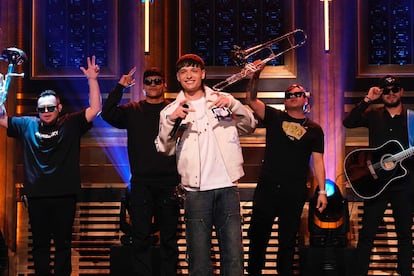Spanglish and beyond: The evolution of Spanish-influenced dialects in the US
If you’ve ever visited cities like Los Angeles, Miami or New York City, chances are you’ve heard a linguistic mashup that feels both familiar and foreign

Throughout the years, we’ve seen numerous Spanish words adopted into English — “fiesta” and “amigo” have become standard vocabulary for many English speakers. And of course everyone knows about salsa and tortillas. A number of phrases incorporating both Spanish and English words have developed, such as “hasta la vista, baby” (thank you Terminator) and “no problemo.” This usage of Spanglish by non-Spanish-speakers illustrates its far-reaching impact. It’s not just a tool for communication within bilingual communities, but also a cultural phenomenon that transcends linguistic boundaries. It’s an example of how language evolves and adapts, reflecting the diverse, multicultural nature of American society.
Spanish is the second most spoken language in the United States. With over 41 million people over the age of five speaking Spanish at home, it’s no wonder that new dialects are emerging in cities with significant Hispanic populations. In Miami, for example, Cuban-Americans have created a unique form of Spanglish known as “Cubonics,” which borrows slang words and grammar from both Cuban Spanish and English. Similarly, the Puerto Rican community in New York City has developed a distinct dialect known as “Nuyorican.”
Cubonics incorporates unique words and phrases. An example is “parquear,” a hybrid that combines the English word “park” with the Spanish verb ending “-ear” to mean “to park.” In Nuyorican, one might hear English speakers say “bodega” to refer to a small grocery store. “Vacunar la carpeta” is another interesting example from Cubonics. This phrase literally translates as “to vaccinate the folder,” but it is colloquially used to mean “to vacuum the carpet,” demonstrating how words from both languages can combine in unexpected ways to create new meanings.
The influence of Spanish has crept into English in unexpected ways. People in Miami often say things like, “get down from the car” (a literal translation of “bajarse del coche”) instead of “get out of the car.” And Mexican Americans throughout the Southwest, who don’t speak Spanish, have a singsongy cadence to their English speech — the “cantadito” so particular to Mexican Spanish.

Prominent voices from these communities offer their unique perspectives on these dialects. In an interview with HyperMedia magazine, Cuban-American author Gustavo Perez Firmat refers to Cubonics as “an expression of our cultural identity... It’s a way of saying, ‘We’re here. We’re Cuban. We’re American. And we’re not going away.’” Likewise, New York City’s Nuyorican community has embraced their dialect as a cultural marker. The New York Times obituary for poet Tato Laviera said he often praised Nuyorican for its capacity to “collapse two cultures and recreate them.”
Amherst University professor Ilan Stavans, who wrote the book, Spanglish: The Making of a New American Language, made waves when he started writing a Spanglish version of Don Quijote. But he defends his fascination with Spanglish. “Languages are never in a state of purity. Instead, they are always changing,” he wrote in 2014. Stavans considers Spanglish a “creative way to transcend borders and enhance one’s identity.”
The impact of these linguistic blends on American culture has been significant, as scholars and community leaders have noted. In a research paper published in the International Journal of Bilingualism, linguist Ana Celia Zentella argues that Spanglish is a powerful tool for identity formation among Hispanic youth in the US, stating that it provides a “linguistic affirmation of their biculturalism.”
Caló originated in the early 20th century among pachucos — Mexican-Americans living in the southwestern U.S. who were known for their distinctive clothing and cultural style. The pachuco Caló dialect incorporates both Spanish and English words with unique syntax and grammar rules, often using code-switching to show group solidarity and to distinguish speakers from outsiders. Caló is still spoken within the Hispanic community, though mainly as an informal or slang language. It represents more than simply a linguistic fusion; it embodies a unique cultural identity formed by the convergence of two distinct worlds — Mexican and American.

On the creative front, the influence of Caló can be seen vividly. Celebrated playwright and filmmaker, Luis Valdez, often incorporates Caló into his work to authentically capture the essence of the Chicano experience. He explains in an interview by El Teatro Campesino, “Caló is part of our heritage... It’s the language of the barrio, the language of the home. It has its own vibrancy, its own life.”
In the Mexican-American communities of the southwestern United States, you’ll occasionally hear English speakers peppering their conversations with Caló phrases and idioms. An example is the word “jefita,” used to affectionately refer to one’s mother. In this context, an English speaker might say, “I need to check in with my jefita before we head out.” Another example is “Don’t chillar over spilled milk,” borrowing the idiom “chill” from English and the verb from Spanish. These examples demonstrate how the Caló dialect has been embraced by English speakers in some parts of the United States, adding to its cultural significance.
Social media has played an important role in popularizing Spanish-influenced dialects in the U.S., with users often creating humorous posts and videos using slang words and phrases from their respective dialects. Examples of Spanish-influenced dialects on social media abound. On Twitter and TikTok, the hashtags #Spanglish or #ChicanoEnglish are frequently used by users sharing content that blends English and Spanish. A popular example is the phrase “¿Y el novio?” This query is often humorously associated with the incessant questioning from family members about one’s relationship status during family gatherings. This phrase has seen countless memes making it familiar even to non-Spanish speaking viewers.
Instagram influencers and celebrities also contribute to this linguistic diffusion. Celebrities like Selena Gómez and Cardi B often incorporate Spanglish or Chicano English in their captions and comments, providing exposure to millions of followers who may not be Spanish speakers. For instance, Cardi B’s famous catchphrase “Okurrr” is a magnificent display of how code-switching can create a unique linguistic style widely adopted by non-Spanish speakers.
These Spanish-influenced dialects serve as a living testament to the rich heritage and cultural amalgamation that is characteristic of American society. They represent the diverse journeys of various communities across generations, encapsulating their histories, struggles, triumphs, and cultural nuances. By preserving these dialects, we provide future generations the opportunity to understand and appreciate the cultural depth of their predecessors, thereby fostering a deeper sense of identity and belonging.
Sign up for our weekly newsletter to get more English-language news coverage from EL PAÍS USA Edition
Tu suscripción se está usando en otro dispositivo
¿Quieres añadir otro usuario a tu suscripción?
Si continúas leyendo en este dispositivo, no se podrá leer en el otro.
FlechaTu suscripción se está usando en otro dispositivo y solo puedes acceder a EL PAÍS desde un dispositivo a la vez.
Si quieres compartir tu cuenta, cambia tu suscripción a la modalidad Premium, así podrás añadir otro usuario. Cada uno accederá con su propia cuenta de email, lo que os permitirá personalizar vuestra experiencia en EL PAÍS.
¿Tienes una suscripción de empresa? Accede aquí para contratar más cuentas.
En el caso de no saber quién está usando tu cuenta, te recomendamos cambiar tu contraseña aquí.
Si decides continuar compartiendo tu cuenta, este mensaje se mostrará en tu dispositivo y en el de la otra persona que está usando tu cuenta de forma indefinida, afectando a tu experiencia de lectura. Puedes consultar aquí los términos y condiciones de la suscripción digital.
More information
Últimas noticias
Welcome to the post-religion era: The idea of Christianity as the absolute truth has become obsolete
‘I thought you would like it’: The risky sexual practice popularized by TV shows and TikTok
The digitalization of tourism: ‘They promise experiences and gave us the worst possible one’
Mexican peso defies uncertainty with forecasts of a new period of stability in 2026
Most viewed
- Sinaloa Cartel war is taking its toll on Los Chapitos
- Reinhard Genzel, Nobel laureate in physics: ‘One-minute videos will never give you the truth’
- Oona Chaplin: ‘I told James Cameron that I was living in a treehouse and starting a permaculture project with a friend’
- Why the price of coffee has skyrocketed: from Brazilian plantations to specialty coffee houses
- Silver prices are going crazy: This is what’s fueling the rally










































